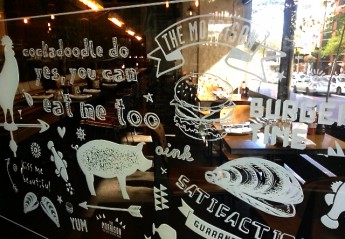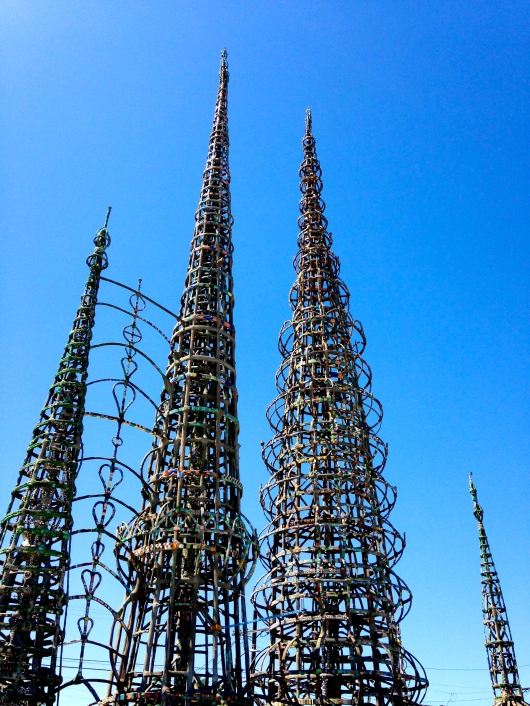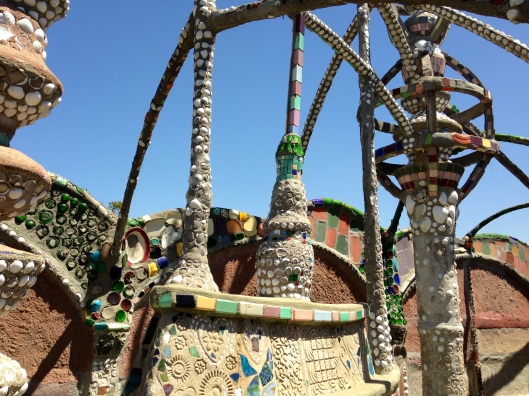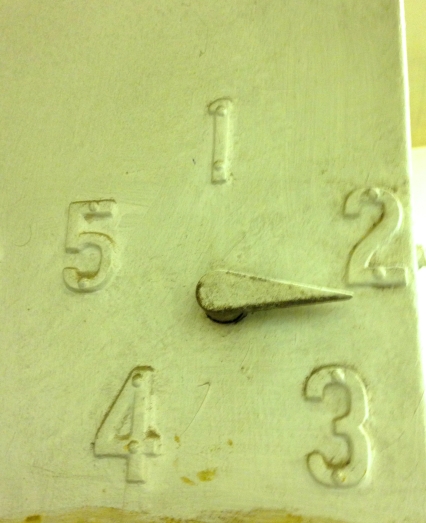I was asked why I decided to spend 6 weeks hiking from France to Spain along the famous Camino de Santiago, and was amazed to hear the words ” I’ve never done a big thing and I really wanted to” come out of my mouth.
When I read that Simon Rodia had said much the same when asked about his Watts Towers I recognized the sentiment.
“I wanted to do a big thing and so I did it.”
I first glimpsed the Towers from the Blue Line enroute to downtown LA from Long Beach, but the neighborhood, post 1992 riots seemed scary. The newspaper photographs from the 1965 unrest flashed through my mind and slowed me from exiting the train. Poetic images of the Towers would appear in magazines, cameos in movies and video games would nudge me to visit, but it took a decade before I finally drove down the tiny streets in Watts to explore.
A big thing in Roddia’s life but almost lost in the suburban megacity that is Los Angeles.
The triangle block is surrounded by small single story homes, an abandoned trolley line runs close by, there’s a small park and remnants of historic 20’s architecture when Watts was a solidly middle class suburb. A suburb growing because of railway lines and jobs and proximity to downtown LA.
Construction worker and immigrant Rodia moved into Watts and built his unique structures from rebar, his own concrete mixture, railway detritus and broken soda bottles and ceramic seconds. Neighborhood kids earned money by “sourcing” the decorative elements.
He built in the evenings, after a days work and often walked 20 miles to Wilmington, along the tracks to find materials. He used no electricity or cranes, but constructed each component by hand.
The towers climb 100 feet into the air. And the project took 33 years in all.
I’m drawn to experience these solitary artistic endeavors.The innate sadness versus the fantastical and exuberant, and the physical scale and decades of labor tug like no other art.
I’m reminded of other outsider art constructions: Hermit’s Cave in Griffith, NSW , Forestiere Underground Garden in Fresno and Salvation Mountain near the Salton Sea.
And I think of artists who’s work I love, totally different mediums but very often huge scale and for me, strong emotional impact like James Turrell, Michael Heizer and Christo.
Rodia left Los Angeles in 1955 never to return. He “quit” the site, apparently exhausted by City threats and permit issues, and after a fire destroyed his bungalow, plans were underway to demolish the towers.
In a serendipitous and magical encounter, an actor and a film editor, having seen the towers and knowing of their abandonment and impending destruction, bought the site from the neighbor and set in process the saving of Rodia’s life work.
To quote Wikipedia : The Watts Towers or “Nuestro Pueblo” are considered one of Southern California’s most culturally significant public artworks.They are one of nine folk art sites listed in the National Register of Historic Places, and were designated a National Historic Landmark in 1990. The towers were also designated a California Historical Landmark in 1990.
The towers are surrounded by a 10ft chain link fence. There is need for continuing restoration but they are not crumbling or in a state of devastation. In fact, on a clear spring day the crazy Gaudiesque towers, ceramic walls, ships and fountain shapes sparkle with seashells and colorful broken china.
Parking and seeing from the street is free but supporting the small Art Center and taking the $7 guided tour is a good thing. Unless you live totally behind gates or in a secluded, perfect and remote place , the neighborhood is fine. A little scruffy in places, but also cheery and cute around the Towers and along the street. Neighbors have decorated in honor and admiration of the art piece they live next to.
This brilliant and unique folk art is visited by 45,000 visitors a year, mostly overseas tourists and school groups.The Watts Towers may be the finest example of LA outsider art AND an international icon but the least visited by people who live locally.
Los Angeles is an art, design and architecture magnet. Full of singular, iconic buildings and neighborhoods and cool places to explore.
Another really big thing to do!
ps: My personal nudge to revisit, Australian school friend, photographer and fellow Hermit’s Cave devotee. Thanks Cilla.




















